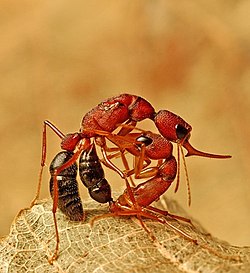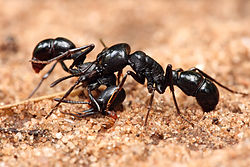| Ponerinae Temporal range: | |
|---|---|
 | |
| Fighting Harpegnathos saltator | |
| Scientific classification | |
| Kingdom: | Animalia |
| Phylum: | Arthropoda |
| Class: | Insecta |
| Order: | Hymenoptera |
| Family: | Formicidae |
| Subfamily: | Ponerinae Lepeletier, 1835 |
| Type genus | |
| Ponera Latreille, 1804 | |
| Diversity [1] | |
| 59 genera | |

Ponerinae, the ponerine ants, [2] is a subfamily of ants in the Poneromorph subfamilies group, with about 1,600 species in 47 extant genera, including Dinoponera gigantea - one of the world's largest species of ant. Mated workers have replaced the queen as the functional egg-layers in several species of ponerine ants. In such queenless species, the reproductive status of workers can only be determined through ovarian dissections.[ citation needed ]
